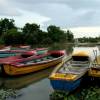Moon Author's Review
The Lower Black River Morass is one of Jamaica's largest wetlands, with 142 square kilometers of mangrove and swamp providing a rich habitat for a variety of animal and plantlife. Turtles and crocodiles are still abundant, while manatees, once relatively common around the mouth of the river, are gone today. It's the largest remaining undisturbed wetland in the English-speaking Caribbean at 7,285 hectares. The Black River Morass has 113 species of plants and 98 species of animals. The Anchovy Pear (Grias cauliflora) of the Brazil Nut family (Lecythidaceae) grows in the morass. Sawgrass, or razor grass (Cladium jamaicensis), first described by botanists in Jamaica and thus given the Latin name jamaicensis, covers about 60 percent of the wetlands area. Sable palm (Sabal jamaicensis), or thatch palm, is another wetland plant abundant in the reserve that was first described in Jamaica.
The crocodiles along the Black River are quite accustomed to being around people, to the point where many tourists think the ones sitting on the river's edge next to the restaurant are tame. While it's not recommended, some people swim in the same water as the crocs, which, according to one seasoned adventurer, are more afraid of us than we are of them. It's best to respect their space, however, and not give them the chance to prove they are anything but friendly.
The Black River and the Lower Black River Morass are best accessed by taking one of the river safari tours that start in the town of Black River, where three tours are offered from the river banks on pontoon boats.





